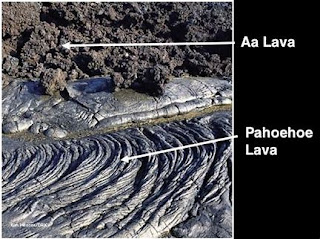Legend in Hawaii talks of the goddess Pele, sometimes appearing to people as a beautiful woman hitchhiking on the side of the road, and sometimes appearing to be a vengeful old witch-like lady. The native Americans believed in a Great Creator (as do many religions) and to an outsider, Pele could be considered that goddess, the princess of fire and creation, the maker of the islands, her sacrifices changing from ohelo berries to bottles of gin (last I heard). Indeed, walking alongside the edge of one of her craters, it would be easy to believe that throwing yourself into the crater and into her arms would be the right thing to do, your mind altered a bit with the enormity and majesty of her creation alongside you (although there is no record of Pele ever "wanting" human sacrifices and none were apparently taken unless you had somehow offended her); hiking inside the Halemaumau crater there are still places where the footprints of early Hawaiian warriors were caught off-guard, Pompeii-style. But Hawaii then was rather brutal overall; glance at royalty in the wrong way, or step in their shadow and it meant death. Pele was often viewed as no different, changing on a whim and sentencing you to life or death in a moment.
Hiking the craters of the Big Island (Hawaii) was something I used to do almost annually, it somehow bringing me peace to start down into the caldera (trails are well-marked in the beginning and then you follow stacked cairns). Peering into fissures and cracks you are more than willing to follow the charted out path since many of the emptied tubes of lava flows are dangerously fragile. The lava comes in two types there, pahoehoe and a'a, the latter of which is jagged and sharp; take a fall and you're cut, or finish a hike and your Vibram soles are deeply worn. And still, the fragile ama'u ferns grow as if newborns, their "twigs" of green poking though the temporarily-hardened cracks of lava. So you hike and hike the 10-mile loop, reaching the caldera at the mid-point, joining the cars and tourists who traveled around the rim on the top, reading the signs and missing all the steam and heat and house-sized chunks of upheaved lava. Still, when the wind shifts and the mist swirls back to envelope the crowd, a Darth Vader-like fog will constricts your throat and makes you gasp in panic for a breath. Sulphur dioxide.
You've likely been reading about the eruptions taking place in Hawaii, the flows of lava making their way to the southeast corner of the island, part of the island formation again in action. And while I won't get into the different types of volcanoes (think Mount St, Helens vs. Vesuvius vs. Stromboli vs. Diamond Head), there is quite a difference when you hike the erupting Kilauea vs. hiking the nearby Mauna Loa (measured ocean base to top, it's still considered both the highest mountain and the largest active volcano in the world). There is something about being so close to our planet's birth, the ground beneath you as solid and as changeable as frozen water. It is time in action, geologic time even as we plaster labels such as active and dormant onto them (a new island, Loihi, is still being formed off the southeast corner of the Big Island). Those who venture beyond the resort side of Kona and move onto the eerie roadway that crosses from there to the other wet side of Hilo (the Hawaiian islands all have a dry side and a wet side which gets more of the rain and moisture, something realized by early farmers who tapped and channeled the waters for their crops). Driving through the fields of broken lava for what seems an excessively long time, it's difficult to picture homes being built on this. But build they do; actually, many home sites are built over earlier home sites that were destroyed by lava flows in previous years. What are the chances that a flow will take the same path again? For the residents of Leilani Estates (the area being the most impacted by this recent lava flow), the odds are not in their favor (the next area over, Nanawale Estates, is untouched...so far).
The island residents are watching nature take its course, perhaps feeling a sickening bond with those who watched their homes destroyed by forest fires or flooding. It's a game of chance we play, living on fault lines or enjoying coastal views. Nature is evolving as it's done for eons, and those who have lived in peace with her have to consider themselves lucky. Years and decades and centuries may pass by with little happening. Oceans come and go, as do glaciers and forests. And perhaps eventually so will we humans, giving way and succumbing to nature. As one local resident being affected by the lava flow told a reporter for the
Honolulu Star Advertiser, "It's always been Pele's home."





Comments
Post a Comment
What do YOU think? Good, bad or indifferent, this blog is happy to hear your thoughts...criticisms, corrections and suggestions always welcome.